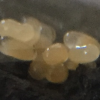Queen 1
1. Location (on a map) of collection: Yucca Valley, CA.
2. Date of collection: Aug. 4 2017
3. Habitat of collection: Desert
4. Length (from head to gaster): 14mm
5. Color, hue, pattern and texture: Yellow-orange with a lighter yellow abdomen and a darker orange thorax.
6. Distinguishing characteristics: Looks very smooth with a few small hairs all over.
7. Distinguishing behavior: N/A
8. Nest description: N/A


Queen 2
1. Location (on a map) of collection: Yucca Valley, California.
2. Date of collection: Aug. 4 2017
3. Habitat of collection: Desert with dry grass and bushes.
4. Length (from head to gaster): 12mm
5. Color, hue, pattern and texture: Orange abdomen with a dark-brown thorax and head.
6. Distinguishing characteristics: has fine hair all over.
7. Distinguishing behavior: N/A
8. Nest description: N/A


Edited by Scrixx, August 9 2017 - 7:59 AM.


















